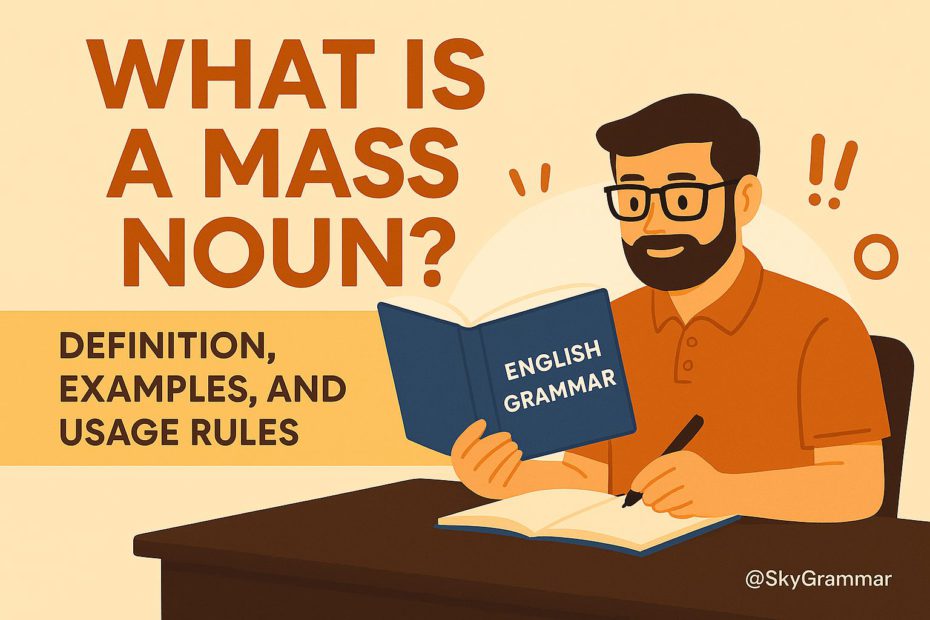When learning English grammar, understanding different types of nouns is essential to building strong communication skills. One important category that often confuses learners is the mass noun, also known as an uncountable noun. Mass nouns are distinctive because they refer to materials, qualities, or abstract concepts that aren’t counted as individual items. In this post, we’ll explore what mass nouns are, how to use them correctly, and common mistakes to avoid.
🔍 What Is a Mass Noun?
A mass noun refers to something that cannot be counted as separate units. Instead of representing individual, distinct items (like “apple” or “book”), mass nouns refer to things seen as wholes or continuous substances. These include things like:
- Materials (e.g., water, sand, air)
- Abstract ideas (e.g., happiness, information)
- Food and drink (e.g., milk, bread, rice)
- Natural elements (e.g., snow, sunlight)
Mass nouns are grammatically singular and usually do not take the plural form or use numbers directly. You wouldn’t say “two breads” or “five informations.”
🧠 Mass Noun vs. Countable Noun
To understand mass nouns more clearly, let’s compare them with countable nouns:
| Mass Noun | Countable Noun |
|---|---|
| Water is refreshing. | The glass of water is full. |
| I love music. | She played three songs. |
| We need furniture. | We bought two chairs and a table. |
Mass nouns describe the substance or concept in general. If you want to talk about a specific amount, you’ll need to use a unit or measurement.
✅ Correct Usage of Mass Nouns
Because mass nouns are uncountable, there are special rules for using them:
1. Use Singular Verbs
Mass nouns are always treated as singular, even though they may refer to large amounts.
- ✅ The water is cold.
- ✅ Milk tastes better when chilled.
- ❌ The sand are hot.
2. Don’t Add an “-s”
Mass nouns do not have plural forms.
- ✅ He gave me some advice.
- ❌ He gave me some advices.
If you want to refer to multiple pieces of something, use a phrase like “pieces of,” “types of,” or “items of.”
- ✅ Several pieces of furniture were damaged.
- ✅ Three types of cheese were offered.
3. Use Quantifiers for Measurement
You can’t count mass nouns directly, so you must use units or containers to describe quantities:
- A glass of water
- A bag of rice
- A slice of bread
- A piece of advice
📂 Common Mass Nouns (With Examples)
Here are several common mass nouns categorized by type:
📘 Substances
- Water: Water covers most of the Earth’s surface.
- Sand: We walked barefoot in the sand.
- Air: The air feels fresh today.
🍽️ Food & Drink
- Milk: Milk is a great source of calcium.
- Rice: She cooks rice every evening.
- Butter: There’s too much butter in this dish.
🧠 Abstract Concepts
- Knowledge: Knowledge is power.
- Information: We received important information.
- Love: Love cannot be measured.
🪑 Materials & Goods
- Furniture: They bought new furniture for the office.
- Equipment: The lab has modern equipment.
- Luggage: Her luggage was heavy.
🚫 Mass Noun Mistakes to Avoid
❌ 1. Adding a Plural Ending
Incorrect: She gave me many informations.
Correct: She gave me a lot of information.
❌ 2. Using “A” or “An” Directly
You cannot use a or an directly before mass nouns.
Incorrect: An equipment was delivered.
Correct: A piece of equipment was delivered.
❌ 3. Treating Them as Countable
Incorrect: I bought two breads.
Correct: I bought two loaves of bread.
🧩 Some Nouns Can Be Both Countable and Uncountable
English is full of exceptions, and some nouns can function as either mass or countable nouns depending on context and meaning.
🔄 Examples:
“Hair”
- Mass noun: Her hair is long and shiny.
- Countable noun: I found two hairs in my soup!
“Light”
- Mass noun: There’s not enough light in the room.
- Countable noun: Turn off the lights before leaving.
“Paper”
- Mass noun: Paper is made from wood pulp.
- Countable noun: I handed out five papers (meaning documents).
“Glass”
- Mass noun: Glass is fragile.
- Countable noun: I drank two glasses of water.
This dual usage can be tricky, so pay attention to context and meaning.
🧱 How to Make Mass Nouns Countable
To refer to a specific quantity of a mass noun, pair it with a countable unit:
- Two bags of rice
- Three pieces of luggage
- Four cups of coffee
- Several bits of information
This approach allows you to measure something typically viewed as uncountable.
📘 Helpful Tip
If you’re unsure whether a noun is countable or uncountable, try this test:
A good rule of thumb is to ask: Can I count this item directly?
If you can naturally say ‘one [item], two [items],’ it’s a countable noun.
If that doesn’t work, you’re probably dealing with a mass noun.
🎓 Conclusion
Mass nouns are a fundamental part of English grammar and mastering their use is essential for writing and speaking clearly. Remember:
- Mass nouns represent uncountable items or ideas.
- They always take singular verbs.
- You cannot pluralize them directly.
- Use measurement words or units to talk about quantity.
Understanding the difference between mass and countable nouns helps avoid common grammar mistakes and improves the clarity of your communication. So next time you’re writing or speaking, take a moment to consider whether the noun you’re using is countable or not—it makes a big difference!

